Protect yourself against IE security holes
Network Administration - Like many other IE users, you've probably heard the phrase 'Security vulnerability in IE'! However, this is a completely new security hole, with this security vulnerability, a malicious website can take advantage of it to access data files on your computer. To help you avoid attacks that exploit this vulnerability, we recommend some tips to help you protect your data safely.
 IE vulnerability threatens Windows XP users
IE vulnerability threatens Windows XP users
Note that these tips are only useful for IE security vulnerabilities.
Make sure your Protected Mode protection is enabled
As with most IE security vulnerabilities, if you are running Windows 7 or Vista, you need to enable Protected Mode, which will run Internet Explorer in a sandbox - to protect you from pages. Web malicious code (though not all).
Go to Internet Options -> Security tab and check the checkbox to activate this mode.
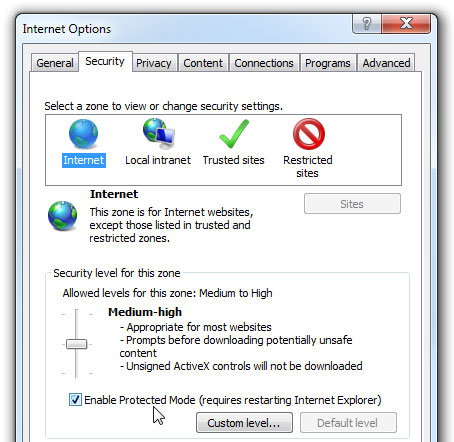
Set up ActiveX Controls in prompt mode (or disable them)
If you drag the slider in the image above to High, you will disable ActiveX Controls, not allowing it to automatically run.
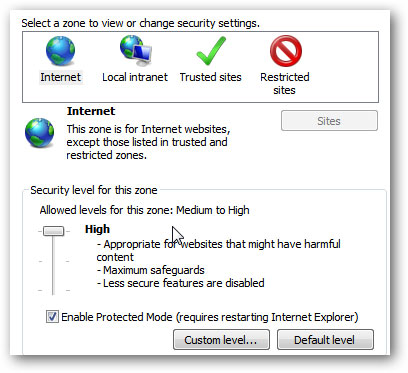
The undesirable side effect is that you will be prompted more when accessing sites that use ActiveX Controls. Microsoft encourages you to add sites that you really trust to your Trusted Sites list . and make sure to clear the 'Require https' checkbox at the bottom.
To add a site to the Trusted Sites, click the Trusted Sites icon shown in the image above, then click the Sites button, type the website URL , and then click the Add button.
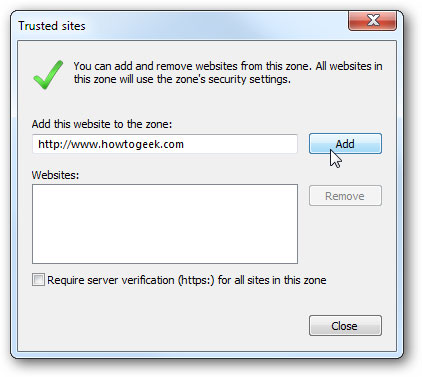
Disable unnecessary plugins
Open Tools -> Manage Add-ons from the IE menu, then change in the drop-down menu under ' Show ' to ' All add-ons '. You will then see a list of all the add-ons that are currently enabled, so we can begin to disable unnecessary add-ons.
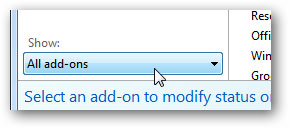
Here, you will have a fairly large list of add-ons and can start disabling them by clicking on them, then clicking Disable . Important note here: Adobe Reader seems to have another security vulnerability and if you don't really need Java support, you can disable it.
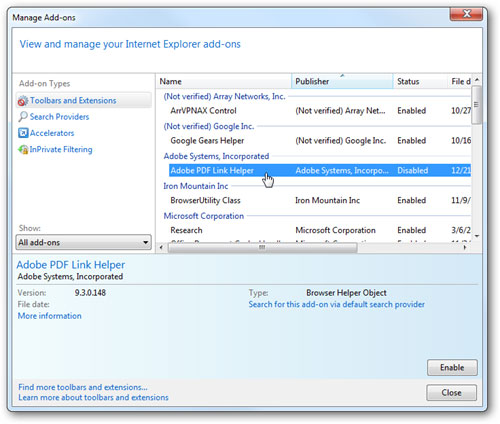
My general principle is to disable what is not needed, or can disable all then re-enable add-ons that you feel really need. Disabling add-ons is the fastest way to make IE run faster.
Use Microsoft FixIt to fix the problem
One of the best things is that Microsoft has recently provided the 'Fix it' feature on their support site - with some problems, you can launch the Microsoft utility and let it solve the problem yourself. yours.
However, in this case, you can use Internet Fix to activate Network Protocol Lockdown. You can click on the image below to access the Microsoft site:

You should read it
- Discovering more vulnerabilities makes Bluetooth devices vulnerable to malicious attacks
- 4 web browsers pay great attention to security
- The security feature prevents the Specter vulnerability, which makes Chrome account for 10-13% more computer RAM
- AMD CPUs also have security vulnerabilities that have existed for many years now!
- The 3 most popular attacks targeting clouds today
- NVIDIA Jetson chipset contains a series of security holes that allow data theft, DDoS attacks
- Internet Explorer has vulnerabilities, unused users are still hacked
- Microsoft fixes a serious security hole
May be interested
- Determine the geographic location of a PC using Windows 7
 one of the highlights of the smartphone is that most are equipped with gps navigation feature that allows easy access to user location instructions. with windows 7 computers, you can rely on geosense to find a location without a gps chip.
one of the highlights of the smartphone is that most are equipped with gps navigation feature that allows easy access to user location instructions. with windows 7 computers, you can rely on geosense to find a location without a gps chip. - Disable keyboard with Keyboard Shortcut in Windows
 if you have a pet or child in the house, then you will realize that an unprotected keyboard is really a disaster - the file is deleted, the job is lost and it's hard to explain the facebook status. update at the on.
if you have a pet or child in the house, then you will realize that an unprotected keyboard is really a disaster - the file is deleted, the job is lost and it's hard to explain the facebook status. update at the on. - Protect Internet connection via SSH
 when two computers are connected via ssh, all data transferred between them is encrypted.
when two computers are connected via ssh, all data transferred between them is encrypted. - 7 layers of security every computer should have
 every time you connect to the network, you are placing the computer and the information stored on your computer facing the dangers lurking online.
every time you connect to the network, you are placing the computer and the information stored on your computer facing the dangers lurking online. - Embed malicious code into PDF file without security error
 attack on the system through malicious code embedded in pdf files whether users open with the latest version of adobe reader or foxit reader.
attack on the system through malicious code embedded in pdf files whether users open with the latest version of adobe reader or foxit reader. - Disable PING response in Windows
 although ping is a very useful tool for network administrators, computer hackers can also use ping to find victims on the internet.
although ping is a very useful tool for network administrators, computer hackers can also use ping to find victims on the internet.






 Protect yourself against the Heartbleed security error
Protect yourself against the Heartbleed security error Detect 2 serious security holes in the Zoom application
Detect 2 serious security holes in the Zoom application How to protect the computer against Meltdown vulnerability on CPU?
How to protect the computer against Meltdown vulnerability on CPU? Internet Explorer has vulnerabilities, unused users are still hacked
Internet Explorer has vulnerabilities, unused users are still hacked AMD patched a series of security holes in the graphics driver for Windows 10
AMD patched a series of security holes in the graphics driver for Windows 10